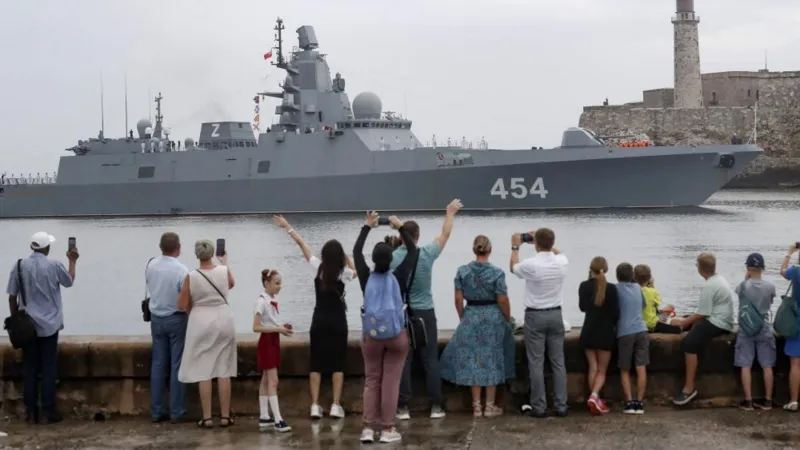In a move that has sparked both curiosity and concern, a fleet of Russian warships, including a nuclear-powered submarine and frigate, has arrived in Cuban waters. The deployment, which began on June 12, 2024, marks the largest Russian naval presence in the Caribbean in recent years. The visit, which is expected to last for five days, has been met with a mix of reactions from the international community, with some viewing it as a routine naval stopover and others as a bold display of military strength.
The Russian fleet, which includes the Admiral Gorshkov frigate, the Kazen nuclear-powered submarine, the Akademik Pashin tanker ship, and the Nikolay Chiker rescue tugboat, is part of a long-standing tradition of Russian naval visits to Cuba. However, the timing of this particular deployment has raised eyebrows given the heightened tensions between Russia and the West over the ongoing conflict in Ukraine.
The Russian Defense Ministry has confirmed that the visit is unofficial and intended to allow the crews to rest and explore local attractions. However, analysts have suggested that the deployment is also meant to send a message to Washington, particularly in light of President Joe Biden’s decision to allow Ukraine to use American weapons to strike Russian targets. Russian President Vladimir Putin has vowed retaliation against not only the US but also other Western allies of Ukraine who have removed restrictions on using the weapons against Moscow.
The Admiral Gorshkov frigate, which is one of Russia’s most modern warships, is equipped with cutting-edge weapons such as Zircon hypersonic missiles, which can fly nine times faster than the speed of sound at a range of over 1,000 kilometers. The Kazan submarine is also believed to be equipped with missiles from the Kaliabr and Oniks families. The presence of these advanced weapons has raised concerns about the potential for military escalation in the region.
Despite these concerns, US officials have stated that they do not view the visit as an imminent threat to their security. They have also clarified that the nuclear-powered submarine is not carrying nuclear weapons on board. The US military’s Southern Command (SOUTHCOM) has confirmed that it is aware of the Russian naval ships and is monitoring their activities closely.
The deployment is seen by some as a show of support for Cuba’s communist government and its socialist ally, Venezuela. Russia has a long history of maintaining close ties with these countries, and the visit is likely to be seen as a symbol of solidarity between Moscow and Havana. The timing of the deployment, which comes ahead of the July 28 presidential election in Venezuela, has raised speculation about whether the Russian warships might to used to shore up President Nicolas Maduro’s bid for a third term.
The presence of Russian warships in the Caribbean has also raised concerns about the potential for military exercises and drills in the region. While the Russian Defense Ministry has not provided details about the nature of these exercises, analysts have suggested that they could involve a handful of Russian ships and support vessels, which may also stop in Venezuela.
The deployment has been met with a mix of reactions from the international community. Some have viewed it as a routine naval stopover, while others have seen it as a bold display of military strength. The visit has also sparked concerns about the potential for military escalation in the region, particularly given the ongoing conflict in Ukraine.
In conclusion, the deployment of Russian warships to Cuba is a significant development in the ongoing tensions between Russia and the West. While the visit is intended to be a routine naval stopover, it has raised concerns about the potential for military escalation in the region. The presence of advanced weapons and the timing of the deployment have sparked speculation about the potential for military exercises and drills in the Caribbean. As the situation continues to unfold, it remains to be seen how the international community will respond to this bold display of military strength.










